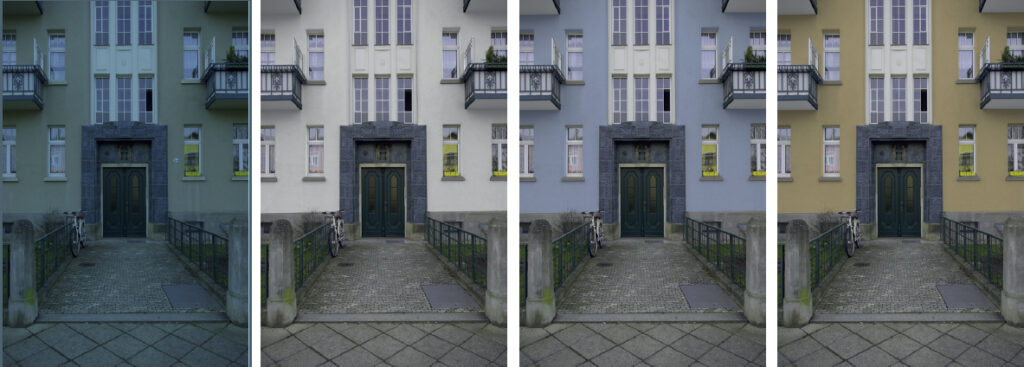Photorealistic colouring of facades in Photoshop - realistic and efficient
PDF+ATN Workshop by Jürgen Opitz
Some software claims to be able to recolour entire houses in a photo-realistic way with just a few clicks. Marking areas of the same colour is done with a click in the respective area, recolouring with another click in the colour palette - and as if by magic, after a few clicks the house shines completely true to reality in new colours.
It would be nice if it were that simple! How is a software supposed to know that the shadow of the tree in front of the house is part of the façade and not a dark other colour area? The example shows: every automatic colouring system has its limits when it comes to real things and not to examples that have been artificially constructed around the abilities of a software. And: there is no way around masking the areas to be coloured by hand.
The situation is similar for the rest of the work. How much should the new colour cover, how much should shadows and the structure of the plaster be lost? Here, a high degree of flexibility of the process is important, because every substrate and every lighting condition behaves differently, standard calculations rarely yield realistic results.
Der Fassadengestalter und Architekt Jürgen Opitz färbt seit vielen Jahren Häuser und Objekte fotorealistisch per Software ein, hat hierzu zahlreiche Seminare und Lehrgänge geleitet. Im Lauf der Jahre hat er ein eigenes Verfahren entwickelt, das er an dieser Stelle vorstellt. Darin findet ein Großteil der Arbeit automatisch statt und das Ergebnis sieht dem Foto des „in echt“ neu verputzten Hauses täuschend ähnlich.
The work takes place in Adobe Photoshop, the applied commands are compiled in a Photoshop actions file (*.atn), which can also be called up in older versions (from CS).
Hier können Sie den Workshop „Architekturfarben 2017“ (.pdf + .atn) herunterladen:
Architectural colours2017.zip
Our founding member Jürgen Opitz passed away in August 2017 after a serious illness. With this workshop, which he wrote in early summer, he wanted to pass on his profound knowledge of realistic colouring to posterity. [:en]
Photorealistic coloring of facades in Photoshop - realistic and efficient
PDF+ATN Workshop of Jürgen Opitz
Some software claims that it can with a few clicks photorealist whole houses. The marking of similar areas is done with a click into the respective area, the colouring with another click into the colour palette - and as by ghost hand the house shines after a few clicks completely reality-lifeless in new colours.
It would be nice if it was so easy! How should a software know that the shadow of the tree in front of the house is part of the facade, and no darker other colour range? The example shows that every colour-coding system has its limits when it comes to real things and not examples that are artificially constructed around the capabilities of a software. And: there is no way past the hand-masking of the areas to be inked.
The same is true of further work. How strongly should the new colour cover, how much shade and the structure of the plaster may be lost? A high degree of flexibility in the process is important, since every background and light condition behaves differently, standard calculations rarely produce realistic results.
For many years, the facade designer and architect Jürgen Opitz has been coloring houses and objects in a photo-realistic way through software, and has conducted numerous seminars and courses. Over the years, he has developed his own method, which he presents at this point. In it a lot of the work takes place automatically and the result looks like the photo of the „in real“ newly plastered house deceptively similar.
The work takes place in Adobe Photoshop, the applied commands are compiled in a Photoshop actions file (* .atn), which can also be called in older versions (from CS).
Here you can download the workshop „Architekturfarben 2017“ (.pdf + .atn):
Architectural colours2017.zip[:]

